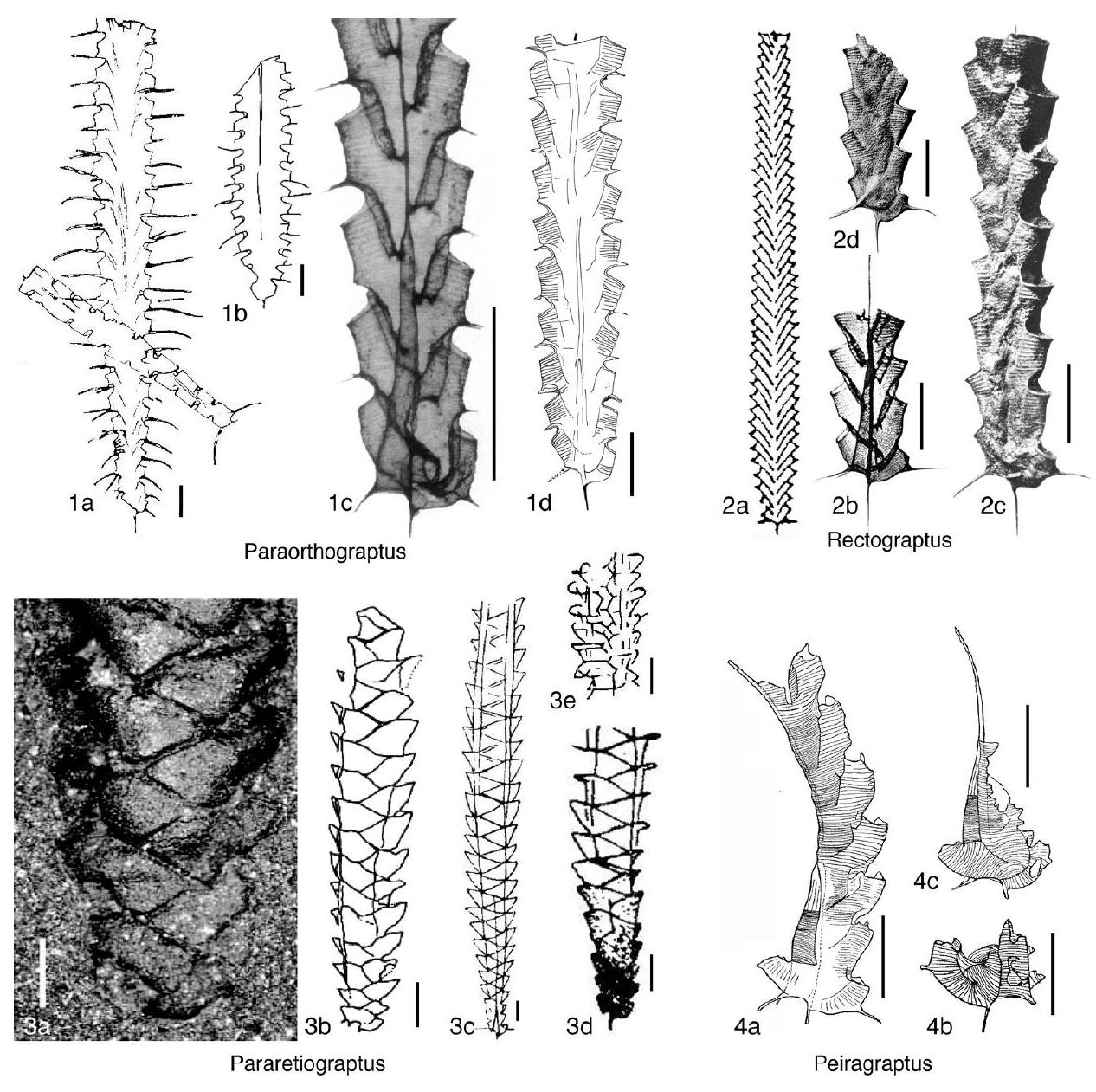Welcome to the Treatise on Invertebrate Paleontology!
Please enter a genera name to retrieve more information.

Paraorthograptus
Classification
Phylum:
Hemichordata
Class:
Pterobranchia
Subclass:
Graptolithina
Order:
Graptoloidea
Suborder:
Axonophora
Infraorder:
Diplograptina
Family:
Diplograptidae
Subfamily:
Peiragraptinae
Formal Genus Name and Reference:
Paraorthograptus Mu & OTHERS, 1974, p. 160
Type Species:
* P. typicus, OD, =Climacograptus innotatus var. pacificus Ruedemann, 1947, p. 429, see WILLIAMS, 1982a, p. 41
Images
(Click to enlarge in a new window)
Fig. 232,1a-c. * P. typicus, 1a, counterpart of holotype, NIGP 21418a, associated with specimen of Appendispinograptus supernus (Elles & Wood, 1906) (Riva, 1988, fig. 5a), 1b, holotype of P. pacificus (Ruedemann), USNM 102838, Phi Kappa Formation, Idaho, USA (Riva, 1974 c , fig. 2f), 1 c, GSC 104924, infrared photo, Cape Phillips Formation, Cornwallis Island, Arctic Canada (Melchin & Anderson, 1998, fig. 1,1). Scale bars, 1 mm, ——Fig. 232,1d. P. manitoulinensis (Caley, 1936), GSC 56900, reverse view, Manitoulin Island, Ontario, Canada, scale bar, 1 mm (Riva, 1988, fig. 5i)
Synonyms
Geographic Distribution
Australia, China, UK, Czech Republic, Canada, USA
Age Range
Beginning Stage in Treatise Usage:
Upper Ordovician (Katian, Paraorthograptus pacificus Biozone)
Beginning International Stage:
Katian
Fraction Up In Beginning Stage:
0
Beginning Date:
452.75
Ending Stage in Treatise Usage:
Upper Ordovician (Hirnantian, Normalograptus persculptus Biozone)
Ending International Stage:
Hirnantian
Fraction Up In Ending Stage:
100
Ending Date:
443.07
Description
Peiragraptines with square proximal end, prominent antivirgellar spines and subapertural spine on th $1^{1}$, but not on th $1^{2}$, thecae geniculate, with outward-inclined supragenicular walls, median septum lacking, proximal development of pattern G astogeny, thecal apertures horizontal or outward inclined with or without apertural cusps, geniculum adorned with paired spines, lobes, or collar
References
Museum or Author Information
Classification
Phylum:
Hemichordata
Class:
Pterobranchia
Subclass:
Graptolithina
Order:
Graptoloidea
Suborder:
Axonophora
Infraorder:
Diplograptina
Family:
Diplograptidae
Subfamily:
Peiragraptinae
Formal Genus Name and Reference:
Paraorthograptus Mu & OTHERS, 1974, p. 160
Type Species:
* P. typicus, OD, =Climacograptus innotatus var. pacificus Ruedemann, 1947, p. 429, see WILLIAMS, 1982a, p. 41
Images
(Click to enlarge in a new window)
Fig. 232,1a-c. * P. typicus, 1a, counterpart of holotype, NIGP 21418a, associated with specimen of Appendispinograptus supernus (Elles & Wood, 1906) (Riva, 1988, fig. 5a), 1b, holotype of P. pacificus (Ruedemann), USNM 102838, Phi Kappa Formation, Idaho, USA (Riva, 1974 c , fig. 2f), 1 c, GSC 104924, infrared photo, Cape Phillips Formation, Cornwallis Island, Arctic Canada (Melchin & Anderson, 1998, fig. 1,1). Scale bars, 1 mm, ——Fig. 232,1d. P. manitoulinensis (Caley, 1936), GSC 56900, reverse view, Manitoulin Island, Ontario, Canada, scale bar, 1 mm (Riva, 1988, fig. 5i)
Synonyms
Geographic Distribution
Australia, China, UK, Czech Republic, Canada, USA
Age Range
Beginning Stage in Treatise Usage:
Upper Ordovician (Katian, Paraorthograptus pacificus Biozone)
Beginning International Stage:
Katian
Fraction Up In Beginning Stage:
0
Beginning Date:
452.75
Ending Stage in Treatise Usage:
Upper Ordovician (Hirnantian, Normalograptus persculptus Biozone)
Ending International Stage:
Hirnantian
Fraction Up In Ending Stage:
100
Ending Date:
443.07
Description
Peiragraptines with square proximal end, prominent antivirgellar spines and subapertural spine on th $1^{1}$, but not on th $1^{2}$, thecae geniculate, with outward-inclined supragenicular walls, median septum lacking, proximal development of pattern G astogeny, thecal apertures horizontal or outward inclined with or without apertural cusps, geniculum adorned with paired spines, lobes, or collar

